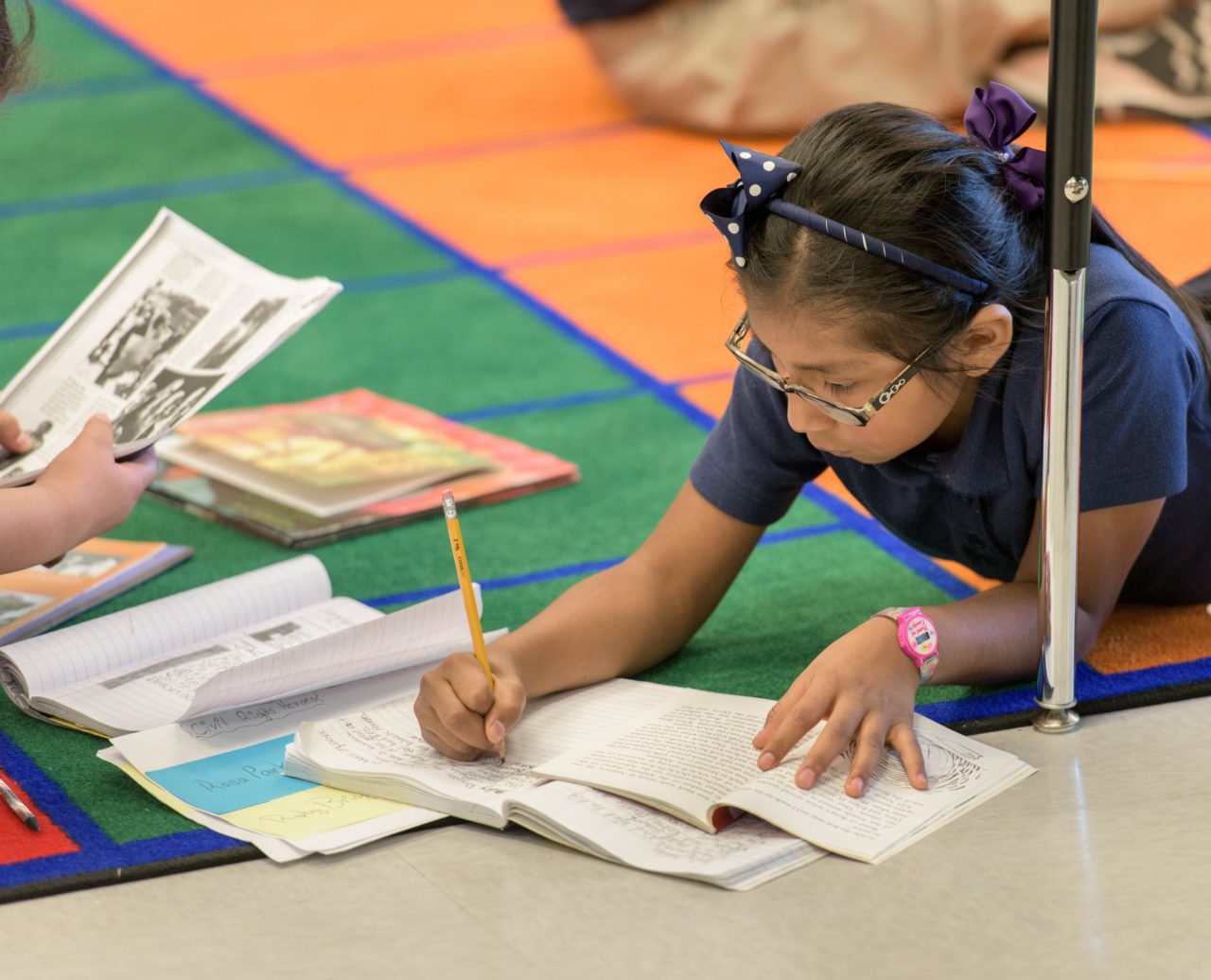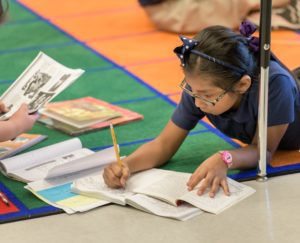
VOICES IN EDUCATION: The Importance of Windows and Mirrors in Stories

Aspire ERES Academy educator, Ms. Kawi, sheds light on how the importance of BIPOC stories can ‘center and empower’ students.
Original PBS Education article can be found here.
by Terry Kawi
Being an English Language Arts teacher is about sharing your love for reading with students, bringing characters to life, modeling how to evaluate and think critically, and artfully choosing texts that help students build knowledge about themselves and the world around them. It is also about storytelling through written and verbal expression and giving students the learning opportunities to practice these skills and find their voice.
As teachers, what we choose to teach and talk about matters, and it is our job to choose topics and texts that reflect our students because they matter. For far too long, our Black, Indigenous, and students of color have either seen themselves tokenized, misrepresented, or not represented at all. It is time to reconsider what texts we view as canon, what voices we regard as worthy, and what themes, storylines, and storytelling mediums are considered academic or rigorous. It is time to select the stories that really matter: ones that center and empower our BIPOC students.
Those whose classes are predominantly white, these stories still matter and are critical to your work as an antiracist educator. I challenge you to assess your existing curriculum, make shifts in your instruction, and commit to bringing diverse voices into your learning spaces (and not just during heritage months or on multicultural diversity day).
Stories as Windows
A window is something you can see the world through, and the texts we put in front of our students should share this quality. When it comes to reading, we have all heard the narrative that books transport readers to different realms and allow us to escape. Or, books give us a way to experience another culture or live the life of a person who may be different from us or may have come long before us. While this all may seem harmless, one can argue that these thoughts are insensitive and lack critical awareness. When we teach students this, we give students the impression that cultures and places in the world require escape, that they are different in a bad way, and this can perpetuate ideas of xenophobia and assimilation.
Instead, what if we were to use windows to learn history, authentic perspectives, and perhaps, shared experiences? What if these windows could help us be better global citizens and teach us ways to navigate, honor culture, and make prosocial choices?
When thinking of windows, consider:
- Who are my students?
- What are their interests?
- What do my students find curious?
- What world knowledge can we build together?
- What connections to prior knowledge can we make?
- Through what ways can I learn different things about my students?
Stories as Mirrors
Mirrors allow us to see ourselves. They show us what we look like, they let us examine ourselves, and they can give us a glimpse of our ancestry and heritage. Sometimes a mirror will show you a part of you that you did not notice before, and there is beauty in that. When choosing stories, they should reflect images of our students’ multiple identities and the world we truly live in.
Seeing ourselves in literature is a gift. It is an empowering experience as a reader to see a protagonist who has a similar name to us and shares a similar background. It is uplifting to meet a character who is like you in some way and relate to them, watch them develop and grow over time in a way that is not cliche. It is inspiring to read an author’s work whose voice feels like that of a family member. It is special to be able to connect with a person you will never get to meet. These mirrors help us see ourselves in relation to the world and help us build connection and a sense of belonging. They also show readers what is possible.
When thinking of mirrors, consider:
- What more do I need to know about my students?
- What are their funds of knowledge?
- How does intersectionality live in our learning spaces?
- How do my students see themselves?
- What activities can I design to help students explore their identity/identities?
- How can I prepare myself so I can best support students in this process?
Thinking Critically About The Texts
We love to tout “rich texts” and “complex texts” but what does that really mean when white authors are massively overrepresented and authors of color are virtually absent in our public school curricula?
When selecting texts, some teachers use the Text Complexity Model, which takes into account:
- Qualitative measures: the makeup of a text including its knowledge demands and levels of meaning
- Quantitative measures: things like Lexile level, text difficulty, and readability.
- The reader and task: the reader’s background, their reading skills and metacognitive reading strategies, prior experiences and funds of knowledge, developmental levels of appropriateness, and the task itself.
I would argue that teachers should also use a critical race lens when selecting texts. To have a critical race lens means to understand oneself deeply in relation to dominant culture and its racist and oppressive systems and policies. It also involves seeing how our experiences may differ from others based on these systems and policies. Teachers who have this awareness cancall out racism in various settings. In terms of text selection, they can choose texts that counter the single story and false narratives as well as challenge token inclusion and interrupt dominant ideologies around assimilation and meritocracy in the existing curriculum.
Here are some questions to help facilitate your text selection process:
Author and Identity– Who wrote this? Can you use poets, artists, and other creatives as storytellers? What values do these authors stand for? Do they have the right to carry BIPOC voices?
Characters and Character Development– Who is the protagonist and how are they developed? What characters are represented and are they misrepresented? Does the character development perpetuate stereotypes or false and harmful narratives? What role does intersectionality play in the story? Do characters look like the different yet full selves of your students?
Themes and Ideas– Do themes mirror assimilationist ideology and make students feel like they need to conform to dominant culture? Do themes teach students that working hard is all you need to do to succeed? Do the hardships and resolutions of stories encourage students to follow the status quo? Are you willing to get rid of texts that do this? Are you prepared to provide students with counter narratives? Do the ideas of the texts uphold white supremacist culture or capitalist culture? For example, ideas of false urgency, perfectionism, and individualism?
Joy and Resilience— Do your texts highlight and showcase the joy of Black people, Indigenous people, and people of color? Do your texts (stories, songs, poems, narratives, articles, art expressions) tell and showcase counter narratives? Do you celebrate joy and tell stories of joy beyond heritage months? If you recognize and applause students for resilience, how do you demonstrate to them why they’re resilient and have had to be resilient? How often are the stories you tell ones of destruction and death? Do your texts explain why students have “grit” and resilience?
Language– Does the language in a text cause harm, marginalize, exclude, etc.? How is language or differences in language portrayed in the text? Is it negative? How can we honor students’ home language and language variants in the texts we put in front of students?
A Quick Note About Nonfiction Texts
There is an abundance of nonfiction texts to choose from in the age of information and ever flowing news cycles. You may choose to analyze articles, news stories, opinion pieces, Tweets, headlines, graphs and charts, and other informational texts. Either way, it is equally important that we choose texts that help teach students about themselves and social issues that arise and those that are all around us. Consider the role you might play in gatekeeping or withholding important information our students deserve to know.
I know that we are all doing and holding a lot as teachers. Whether you are teaching in a classroom, from a distance, or in a hybrid or blended learning environment, know that you are not alone. May you continue to show up and bring life to the stories that matter.